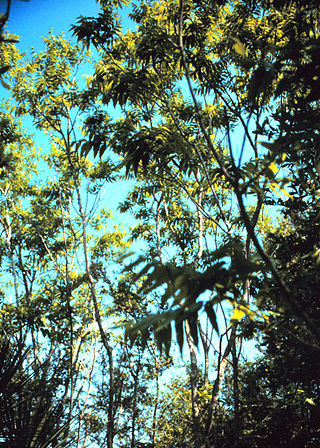
Alectryon is a genus of about 30 species of trees and shrubs from the family Sapindaceae. They grow naturally across Australasia, Papuasia, Melanesia, western Polynesia, east Malesia and Southeast Asia, including across mainland Australia, especially diverse in eastern Queensland and New South Wales, the Torres Strait Islands, New Guinea, the Solomon Islands, New Caledonia, New Zealand, Vanuatu, Fiji, Samoa, Hawaii, Indonesia and the Philippines. They grow in a wide variety of natural habitats, from rainforests, gallery forests and coastal forests to arid savannas and heaths.
Tina is a genus of tropical trees in the family Sapindaceae, native to the eastern coast of Madagascar.

Canarium is a genus of about 120 species of tropical and subtropical trees, in the family Burseraceae. They grow naturally across tropical Africa, south and southeast Asia, Indochina, Malesia, Australia and western Pacific Islands; including from southern Nigeria east to Madagascar, Mauritius, Sri Lanka and India; from Burma, Malaysia and Thailand through the Malay Peninsula and Vietnam to south China, Taiwan and the Philippines; through Borneo, Indonesia, Timor and New Guinea, through to the Solomon Islands, Vanuatu, New Caledonia, Fiji, Samoa, Tonga and Palau.

Sapindus is a genus of about thirteen species of shrubs and small trees in the lychee family, Sapindaceae and tribe Sapindeae. It is native to warm temperate to tropical regions of the world. The genus includes both deciduous and evergreen species. Members of the genus are commonly known as soapberries or soapnuts because the fruit pulp is used to make soap. The generic name is derived from the Latin words sapo, meaning "soap", and indicus, meaning "of India".

Harpullia is a genus of about 27 species of small to medium-sized rainforest trees from the family Sapindaceae. They have a wide distribution ranging from India eastwards through Malesia, Papuasia and Australasia to the Pacific Islands. They grow naturally usually in or on the margins of rainforests or associated vegetation. Plants in the genus Harpullia are usually dioecious shrubs or trees covered with simple or star-shaped hairs. The leaves are paripinnate and the flowers are usually arranged in leaf axils, usually with 5 petals, 5 to 8 stamens and a 2-locular ovary. The fruit is a 2-lobed capsule.

Jagera is a genus of 4 species of forest trees known to science, constituting part of the plant family Sapindaceae.

Diploglottis is a genus of 11 species in the lychee and maple family Sapindaceae. Most species only occur in the Wet Tropics bioregion of Queensland, but all species except one are endemic to eastern Australia, with the exception being D. diphyllostegia, which also occurs in New Guinea. They are commonly called tamarinds, for example northern tamarind, Babinda tamarind and Bernie's tamarind, however they are not closely related to the true tamarind from the family Fabaceae.

Arytera is a genus of about twenty–eight species known to science, of trees and shrubs and constituting part of the plant family Sapindaceae. They grow naturally in New Guinea, Indonesia, New Caledonia, Australia, the Solomon Islands, Vanuatu, Fiji, Samoa, Tonga; and the most widespread species and type species A. littoralis grows throughout Malesia and across Southeast Asia, from NE. India, southern China, Borneo, Malaysia, Singapore, Indonesia and the Philippines to as far east as New Guinea and the Solomon Islands.

Atalaya is a genus of eighteen species of trees and shrubs of the plant family Sapindaceae. As of 2013 fourteen species grow naturally in Australia and in neighbouring New Guinea only one endemic species is known to science. Three species are known growing naturally in southern Africa, including two species endemic to South Africa and one species in South Africa, Eswatini and Mozambique.

Elattostachys is a genus of about 21 species of trees known to science, constituting part of the plant family Sapindaceae.

Mischocarpus is a genus of about nineteen species of trees known to science, constituting part of the plant family Sapindaceae. They grow naturally from Australia and New Guinea, though Malesia as far north as the Philippines, through SE. Asia, Indo-China and S. China, to India at their farthest west. The eleven Australian species known to science grow naturally in the rainforests of the eastern coastal zone of New South Wales and Queensland, from Newcastle northwards through to north-eastern Queensland and Cape York Peninsula.

Dodonaeoideae is a subfamily of flowering plants in the soapberry family, Sapindaceae.
Tristiropsis is a genus of flowering tree species, of the plant family Sapindaceae and the monotypic tribe Tristiropsideae; its native range is Malesia, eastern Australia and the south-western Pacific.

Mischarytera is a genus of rainforest trees, constituting part of the plant family Sapindaceae. Four species are known to science as of December 2013, found growing naturally in eastern Queensland, Australia, and in New Guinea. Formerly until 1995, they had names within the genus Arytera, subgenus Mischarytera.

Sarcotoechia is a genus of tropical rainforest trees, constituting part of the plant family Sapindaceae.
Trigonachras is a genus of 8 species of trees known to science, constituting part of the plant family Sapindaceae.

Sapindoideae is a subfamily of flowering plants in the soapberry family, Sapindaceae. It includes a number of fruit trees, including lychees, longans, rambutans, and quenepas.
Lepidocupania is a genus of flowering plants in family Sapindaceae. It contains 21 species native to the tropical west Pacific, including the Caroline Islands, Fiji, New Caledonia, Samoan Islands, Solomon Islands, Tonga, and Vanuatu.
Neoarytera is a genus of flowering plants in family Sapindaceae. It includes four species native to New Caledonia and Vanuatu.













